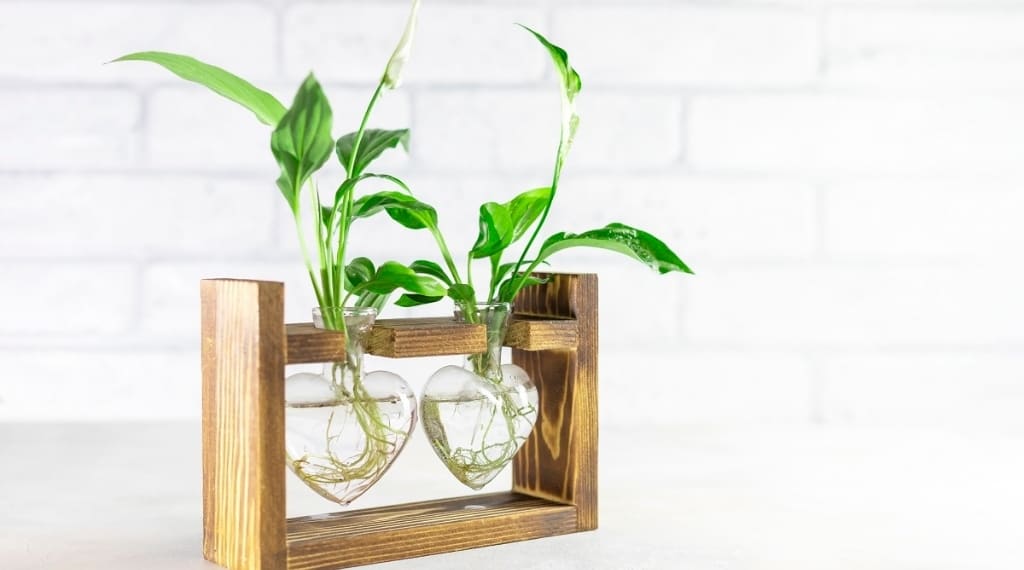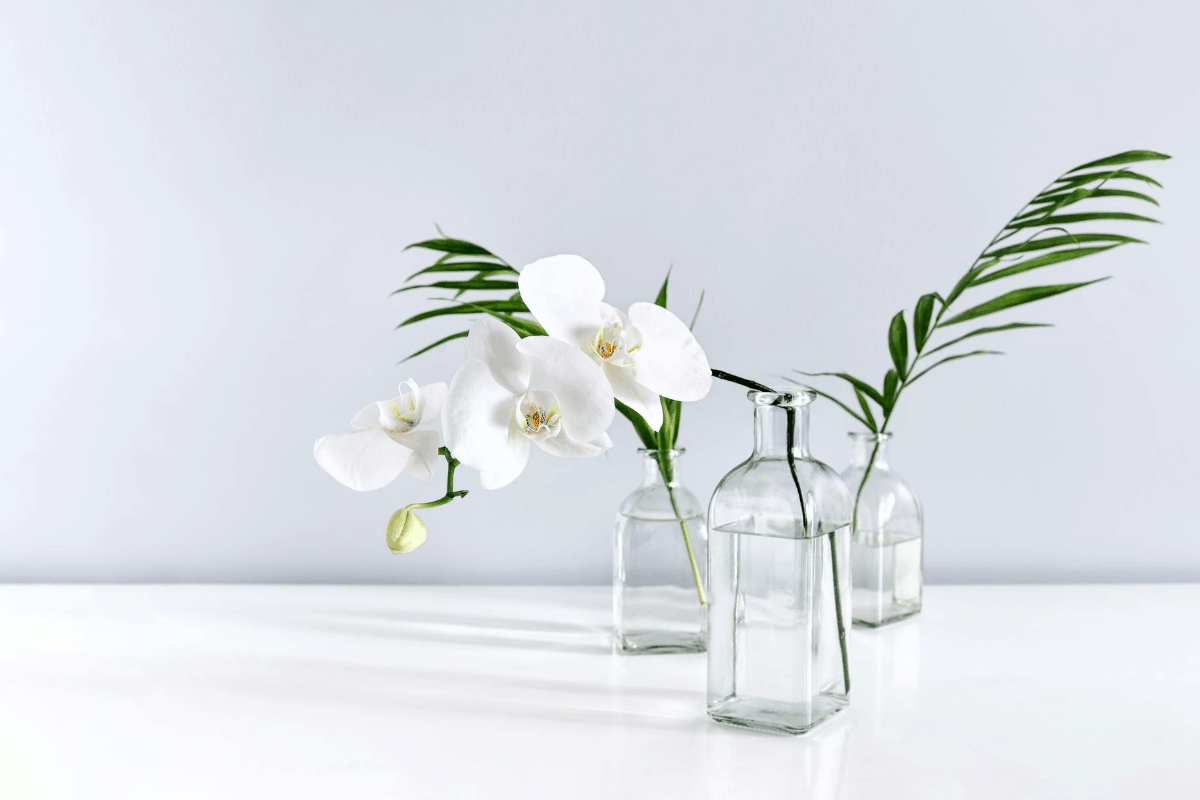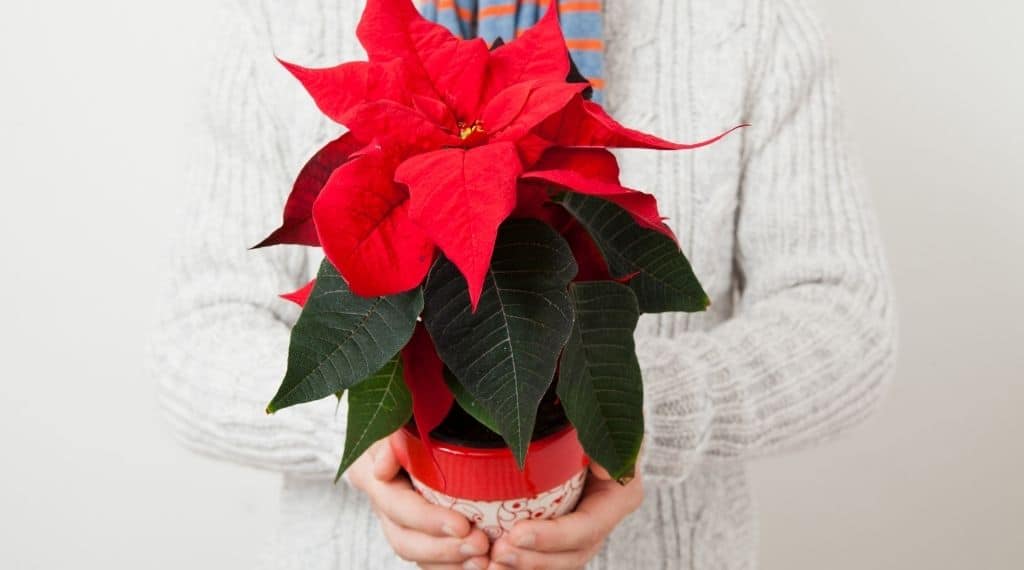Last Updated on October 5, 2021 by Plantiful Interiors
Houseplants are an excellent way to purify the air and add a splash of color to the little corners and cubbies of our homes.
It’s common that once you have one plant, you’re likely to want more. So, what if I told you there’s a way you can add to your plant collection without spending a dime?
The best way to multiply your collection of plants for FREE is through plant propagation.
By learning how to root plant cuttings in water, you can share your plants with friends, grow more of your favorites, start your own small business or create a fresh trendy look in your living room.
Growing a plant from a cutting in water is not only incredibly satisfying, it’s perfect for those who tend to forget to water their plants, or worry about overwatering.
However, some plants are more suitable for growing in water than others so be sure to do a little research on your plant first.
Below, you’ll find a short list of some of the most common and easy plants to root in water, along with the exact steps for how to propagate plants in water.
Stick around to the end where we cover the pros and cons of growing plants in water, along with some commonly asked questions.
This site features affiliate content. As an affiliate partner of various brands, we earn commissions on qualifying purchases, at no extra cost to you. Please read our disclaimer for more information.
Which plants are suitable for rooting in water?
Different plants have different needs, and some plants will not do well submerged in water.
The practice of rooting plants in water relies on a plant’s ability to sit in liquid for a period of time, which often goes against most of the rules you will have learned about plant care i.e. plants left sitting in water will develop root rot.
However, some plants have adapted to being submerged in bodies of water, such as Aroid plants, whose ancestors (yes, plants have ancestors, just like us!) grew in swamps and marshes.
Some of the most common houseplants that can grow from cuttings in water include:
- Pothos
- ZZ plant
- Bamboo
- Peace Lily
- English Ivy
- Spider Plant
- Philodendrons
- Chinese Evergreen
For a complete list of plants suitable for rooting in water, check out this article by Hydro-Culture.
How to propagate plant cuttings in water
So now you know which plants you can grow in water, let’s look at how to grow houseplants in water from cuttings.
As mentioned earlier, this process is known as plant propagation.
What you’ll need:
- the plant you’ll be taking a cutting from
- a pair of sharp clean scissors
- a glass vase or jar filled between one quarter and half full with room-temperature water
Once you have these things ready, it’s time to take some cuttings.
This is where a lot of people go wrong; taking a cutting from the wrong part of the plant and then wondering why their plant isn’t growing roots. Let’s make sure that doesn’t happen to you!
Here’s a summary of the steps you’ll take to grow a plant from a cutting in water:
- identify a good stem to cut – make sure it’s healthy (no yellowing or brown spots)
- find some nodes on the stem to determine where you’ll cut
- use a sharp pair of scissors to cut ¼†below the node – make sure the cutting is long enough to stand upright in your container (approx. 3-6 inches)
- fill your container with enough water to cover the bottom quarter of your cutting – use room-temperature water
- place your cutting in the container with water
- patiently wait for the roots to begin to form, changing the water once per week
- it can take 4-6 weeks or even months for roots to begin growing, depending on the type of plant
Now that you know what to expect, let’s look at each step in a bit more detail to help you get the best plant propagation results.
1. Find a good stem to cut
A common mistake people make is taking a cutting from an old stem and/or cutting the stem too short.
You want to find a strong, healthy stem with green leaves and plenty of nodes on it.
Never take a cutting from a stem that has produced a flower, as the stem will be at the last stages of its life.
Also, avoid using a stem that has brown spots or yellow leaves as this could be an indication that that part of the plant is unhealthy, which is unlikely to produce new roots.
2. Find some nodes
Nodes are the little bumps found along the stem of your plant. They’re usually very easy to see.
It’s these nodes that will produce your cutting’s new roots which is why it’s essential that your cutting include some nodes. Your plant will also produce roots from the bottom of the cut stem.
Along with including at least 1 node on your cutting, you’ll want to include a few leaves as well. However, you’ll need to remove any leaves from the area that will be submerged in water.
3. Take the cutting
Using a sharp, clean pair of scissors, cut your chosen stem about ¼†below the node.
Remember, you want to include the node, as this is where the new roots will form.
Make sure the cutting is going to be long enough to stand upright, well above the rim of the container on its own; you don’t want the whole thing to be sitting in water.
Finally, always use sharp scissors to make the cut, as blunt ones can damage the stem.
The picture below shows two different areas where you could cut this philodendron stem based on where the nodes are located.
4. Place your cutting in water
Now that you have your lovely new cutting, simply put it in your container of choice with room-temperature water so that the bottom quarter of the cutting is fully submerged in water.
Place the container in an area where it will receive bright indirect light.
Make sure the base of the stem and the nodes are submerged but don’t let any of the leaves touch the water.
5. Be patient!
Many people ask, how long does it take to root a plant in water? Your new cutting won’t grow roots overnight, so you’ll have to be a little patient.
Roots can take approximately 4-6 weeks to grow in water, but could be longer depending on the type of plant you’re trying to grow.
Wait until the new roots are at least 1 inch long before you consider transplanting your plant to soil.
6. Give your cutting fresh water weekly
Just because you’re not using soil, it doesn’t mean you can place your cutting in water and forget about it.
Water evaporates and can become murky and stagnant. Keep an eye on the level of the water and its clarity.
It’s suggested to change the water each week.
In between water changes, if you notice the water evaporating quickly, you can top it up with a little fresh tepid water if needed.
Just make sure you always use room-temperature water, as too hot or too cold can shock your plant and cause health problems.
In this video, Erica by Design shows you how she is growing 8 different types of plant cuttings in water:
Should I keep my plant cuttings in water or move them to soil?
So, you’ve waited 4 to 6 weeks and you now have a healthy stem with lots of lovely roots trailing out from the bottom. What now?
This is when you must make the decision: do you want to transplant your new plant into soil, or continue to keep the plant in water?
Before you decide, let’s take a look at the pros and cons of keeping houseplants in water:
Pros of leaving root cuttings in water
Plants need to be acclimated to their new environment
We’ve seen many times when a plant is rooted in water then transferred to soil it dies soon after. Your plant has become accustomed to its water environment which may be a good reason to leave it this way.
If you do plan on transplanting a plant that was rooted in water to soil, you’ll want to gradually introduce the soil to the plant. You can do this by adding a bit of soil to the water every week. This process will take time and needs patience but is the safest way to introduce your plant to its new environment.
Plants rooted in water have a greater amount of oxygen available as to when they are potted in soil, be sure to use a potting mix that provides good aeration.
Houseplants in water provide an elegant and trendy look
There’s no denying that plants sitting serenely in a vase of clear, fresh water looks beautiful. Almost ethereal. Leaving your plants in water makes it easier to transfer the plant into a new container for a fresh new look or when the roots have outgrown the container it’s in.
No dirt, no mess
Not having to deal with soil, or kids and animals who like to play with it, means no dirty footprints and no mess.
Soil is also more likely to attract bugs that like to hide in the dark, warm moist soil. Leaving your plants in water doesn’t completely eliminate the possibility of bugs but it does reduce it.
Visually seeing the roots to determine plant health
If your plant is showing signs of being unwell, it can be a bit of a guessing game as to what the problem is if your plant is in soil.
Have you over-watered it? Under-watered it? Without sticking your fingers into the soil, or pulling up the plant to take a look at the roots, there’s a lot of guesswork involved.
However, if your plant is in a transparent container in water, it’s easy to see the roots to know if there is any rot occurring.
Cons of leaving root cuttings in water
Limited options for which plants can be grown in water
As listed above, there are plenty of plants that will do well living in water, but unfortunately, there are a lot that won’t.
Soil is tried and tested, and the majority of plants prefer to live out their days in a pot of nutritious soil.
Need to change the water frequently
While all plants are susceptible to attracting pests, houseplants that are sat in water all day will also have the added mild annoyance of the water getting cloudy and, if left for too long, smelly.
Much like a fish tank that needs to be cleaned regularly to prevent any buildup of scum on the glass, the container for your houseplant is no different. You will need to be careful when cleaning your container as you don’t want to use any chemicals that could stick to the glass and be hurtful to your plants.
Placement may be limited
Although it sounds great being able to say goodbye to the possibility of soil-filled, dirty footprints being stomped throughout your home if a pet or child gets into your potted plant, you’ll still need to be careful where you place your houseplant in water.
Soil might be irritating, but just think what an entire container of water could do if dropped onto a TV or electrical socket. If you have little people or little paws running around, it’s advisable to place your houseplants in a spot that is unreachable and isn’t near any electrical outlets.
Participate in a plant exchange
To really be able to expand your plant family on the cheap, look for plant cutting exchange groups on Facebook and in your local community.
Or, start your own plant exchange. Ask your friends, family and co-workers which plants they have and if they’d be willing to take one or two cuttings to swap with someone else.
Share this article with them so they know exactly where to cut and what to do with the cuttings they receive. Each week you can check in and discuss how your plant cuttings are doing and share tips. Eventually, those plant cuttings will grow enough that they can be used as new cuttings to start the process over with.
Rooting plants in water is an easy, affordable, and less messy way to add to your plant family. Now that you know you can grow plants without soil and how to root plant cuttings in water, are you going to give it a try? Let us know in the comments below.








